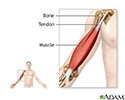Tendon repair
Repair of tendon
Tendon repair is surgery to repair damaged or torn tendons.
Description
Tendon repairs can often be done in an outpatient setting. Hospital stays, if any, are short.
Tendon repair can be performed using:
- Local anesthesia (immediate area of the surgery is pain-free)
- Regional anesthesia (local and surrounding areas are pain-free)
- General anesthesia (asleep and pain-free)
The surgeon makes a cut on the skin over the injured tendon. The damaged or torn ends of the tendon are sewn together.
If the tendon has been severely injured, a tendon graft may be needed.
- In this case, a piece of tendon from the foot, toe, or another part of the body is often used.
- If needed, tendons are reattached to the surrounding tissue.
- The surgeon examines the area to see if there are any injuries to nerves and blood vessels.
- When the repair is complete, the wound is closed.
If the tendon damage is too severe, the repair and reconstruction may have to be done at different times. The surgeon will perform one surgery to repair part of the injury. Another surgery will be done at a later time to finish repairing the tendon.
Why the Procedure Is Performed
The goal of tendon repair is to bring back normal function of joints or surrounding tissues a tendon injury or tear.
Risks
Risks of anesthesia and surgery in general include:
- Reactions to medicines, breathing problems
- Bleeding, blood clots, infection
Risks of this procedure include:
- Scar tissue that prevents smooth movements
- Pain that does not go away
- Partial loss of function in the involved joint
- Stiffness of the joint
- The tendon tears again
After the Procedure
Healing may take 6 to 12 weeks. During that time:
- The injured part may need to be kept in a splint or cast. Later, a brace that allows movement may be used.
- You'll be taught exercises to help the tendon heal and limit scar tissue.
Outlook (Prognosis)
Most tendon repairs are successful with proper and continued physical therapy.
References
Cannon DL. Flexor and extensor tendon injuries. In: Canale ST, Beaty JH, eds. Campbell's Operative Orthopaedics . 12th ed. Philadelphia, PA: Elsevier Mosby; 2013:chap 66.
Irwin TA. Tendon injuries of the foot and ankle. In: Miller MD, Thompson SR, eds. DeLee and Drez's Orthopaedic Sports Medicine . 4th ed. Philadelphia, PA: Elsevier Saunders; 2015:chap 117.
Review Date: 9/22/2016
Reviewed By: C. Benjamin Ma, MD, Professor, Chief, Sports Medicine and Shoulder Service, UCSF Department of Orthopaedic Surgery, San Francisco, CA. Also reviewed by David Zieve, MD, MHA, Isla Ogilvie, PhD, and the A.D.A.M. Editorial team.

